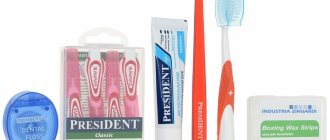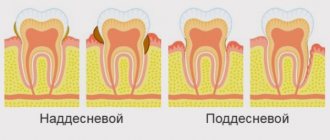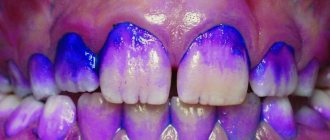Composition of tooth enamel
Dental enamel is the most durable, wear-resistant and hard component in the human body. It represents the outer or surface layer of the teeth, completely covers its coronal and partially cervical part, and also performs protective functions. The main characteristics of enamel include:
- The color of tooth enamel varies from white to yellowish, and it can change shade (color) depending on a person’s dietary habits or bad habits.
- The thickest areas of enamel cover the chewing molars in the area of their anatomical tubercles; their thickness varies between 2.3-3.5 mm;
- The thinnest areas of tooth enamel are localized in paroxysmal areas (places of contact in their lateral projection), here the thickness of the protective layer reaches approximately 1.3 mm;
- The enamel that covers all the teeth in the human oral cavity is not capable of regeneration, because there are no living cellular structures in the tissues of this protective layer;
- Depending on the characteristics of each person’s body, up to 95% of the chemical composition of tooth enamel is presented in the form of mineral compounds. The remaining percentage is divided between water and organic matter in approximately a 2:1 ratio, respectively. In addition, depending on the percentage of mineral content of tooth enamel, it can be more or less transparent (the higher the percentage of minerals, the more transparent the enamel becomes).
Plaque
In many places, the pellicle of the tooth may be covered with a layer of plaque.
Perhaps the formation of a pellicle is the initial stage of the formation of dental plaque or, conversely, dental plaque eventually turns into a pellicle. Meckel (1965) considered the pellicle as old dental plaque, which was modified due to the dissolution of the bacteria it contained. Dental plaque was studied using staining, chemical analyses, electrophoresis, electron microscopy and other modern research methods. There are difficulties in obtaining sufficient plaque for chemical analyses. Samples are often contaminated with components of oral fluid. At the same time, it is known that saliva sediment cannot be used for analysis as a substitute for dental plaque.
Mandel et al. (1957) proposed collecting plaque on strips of foil or other material attached to the teeth. Plaque can also be collected on artificial teeth. Per 1 mg of dry mass of dental plaque there are 3.37 mcg of calcium, 8.37 mcg of phosphorus, 4.20 mcg of potassium, 1.30 mcg of sodium. Calcium and phosphorus in dental plaque are mainly formed from saliva, although other sources are possible. Thus, Luoma (1964) found in dental plaque from 14 to 45% of radioactive phosphorus (32P), which entered it from the enamel. In samples of two to three days of dental plaque in young people, the content of phosphorus, sodium and potassium is higher than in saliva.
The concentration of inorganic plaque salts increases over time. About 40% of the dry mass of inorganic plaque material is present in the form of oxyapatite. However, the mechanism and conditions for the synthesis of apatites in dental plaque, as well as the significance of this process for the tooth, have not been sufficiently studied.
Metabolic reactions of phosphorus in dental plaque are largely dependent on carbohydrates. The phosphate content in dental plaque decreases by 1/3 when sugar remains in the mouth for fifteen minutes.
The pH value has a significant influence on the adsorption of phosphorus in dental plaque. Thus, at a pH of 7.0-7.4, the absorption of radioactive phosphorus (32P in experiments with dental plaque cells) is accelerated. The optimal rate of accumulation of this element occurs at pH 6.8–7.0.
Other components in the enamel
In addition to the already mentioned main components of the enamel layer of the tooth, its chemical composition also contains a set of other components:
- Neonatal line - present exclusively on baby teeth, it looks like a dark-colored stripe (almost black). This line is located in the area of contact between two types of enamel, the first of which was formed before the baby was born, and the second after.
- Bundles and plates of dental enamel are special enamel formations containing prisms of a hypomineralized type, between which the interprismatic substance consists of the same material. It is noteworthy that the molecular structure of this material involves a large number of protein compounds. Many dentists are of the opinion that through the mentioned bundles and plates, various microorganisms penetrate into the enamel from the oral cavity, making their way to deeper dental tissues, causing caries, etc.
- Gunter-Schräger stripes are lines that stand out on the tooth enamel in a darker or lighter shade, the width of which does not exceed 100 microns. They are located perpendicular to the surface of the enamel layer and are formed as a result of opening its prisms.
- Retzius lines - in shape they resemble arches offset from the central one, located symmetrically in relation to each other. When cut across a tooth , these formations resemble rings inside a tree trunk. The formation of Retzius lines corresponds to different periods of mineralization of the enamel layer.
Methods of prevention and treatment
Both prevention and treatment come down to careful and thorough oral care. It is necessary to strictly follow the rules in order to protect yourself from the formation of pathological plaque:
- Brushing your teeth twice a day – morning and evening, for at least 2 minutes, and using properly selected products. It is important to use a brush with medium-hard bristles (even if gum inflammation is present); one that is too soft will not cope with deposits,
- using dental floss and irrigator after every meal,
- using interdental brushes to help clean narrow spaces between teeth,
- Visit your dentist every six months for a checkup.
But you should understand that even with careful hygiene, plaque will still accumulate. For example, under the gums. And even if you missed cleaning at least once or were unable to use the product after meals, especially against the background of reduced immunity or hormonal changes, plaque will again accumulate in greater quantities. Therefore, it is very important to periodically seek help from a dentist for professional oral hygiene.
Professional oral hygiene The procedure allows you to quickly and effectively remove plaque and tartar, as well as get rid of subgingival deposits. For this, an integrated approach is used: ultrasound, Air Flow air abrasive device, manual cleaning, chemical destruction of deposits (if necessary), as well as thorough polishing of the enamel and application of a strengthening composition. This is an excellent method of preventing many oral diseases. It is recommended to carry out an average of 1-2 times a year.
Price:
3000 rubles more details about the solution
Treatment with the Vector and Varius apparatus The use of apparatus treatment is advisable in the presence of pathological gingival pockets in which plaque and stone accumulate, and there is also pronounced inflammation of the mucous membranes. These devices allow you to remove stone located deep under the gums due to targeted vertical action along the tooth, unlike conventional ultrasonic scalers.
Price:
10,000 rubles more about the solution
Features of the structure of the enamel of baby teeth
The main distinguishing feature of the enamel layer of children's teeth is that it is less durable and also much thinner than the enamel of permanent teeth. This is explained by the lower content of mineral compounds in teeth in relation to water and organic substances. Considering these features, if you examine baby teeth and their enamel layer under a microscope, you will notice the following differences:
- Due to the fact that the service life, as well as periods of mineralization and the tendency towards this process are shorter, the Retzius lines are much less pronounced in the structure of primary dental units.
- If in permanent teeth enamel prisms are located apically, then in milk teeth their direction is completely different, they are located horizontally.
- In children's primary teeth, the final enamel layer is much less pronounced; prisms are clearly visible on its surface, while its structure is much more porous, with microscopic cracks present.
Under the influence of each of these features, tooth enamel in children is more susceptible to wear and damage. For this reason, children develop caries much more often and it progresses faster, which is why it is important to visit the dentist regularly and have their teeth treated in a timely manner.
Types of damage to tooth enamel
Over the course of life, even if you provide your teeth with proper care and follow the rules of oral hygiene prescribed by dentists, the enamel layer gradually wears out and is destroyed. This contributes to the occurrence of various diseases of the oral cavity; it is influenced by the food a person eats, etc.
Among the main causes of damage and destruction of tooth enamel, dentists identify:
- Erosion is damage to the enamel layer, and then dentin, which is not associated with carious lesions of the teeth . The essence of this pathological process lies in disorders of mineral metabolism. As a result, disturbances occur in the crystalline structure of the enamel, which is manifested by its focal thinning and destruction. Externally, erosions look like local darkening on a round or oval tooth. The occurrence of erosions is provoked by the consumption of foods with high acidity levels, pathologies of the gastrointestinal tract, the use of certain medications, and the use of aggressive tooth powder or paste.
- Excessive sensitivity of tooth enamel - this disorder is especially pronounced in the form of painful sensations when the teeth cold or hot food, drinks, and even as a result of contact with cool air. The sensitivity of tooth enamel develops due to its thinning under the influence of the factors already described above. A thinned enamel layer puts teeth at increased risk of caries and other dental pathologies.
- Necrosis - this term characterizes multiple lesions of the hard tissues of the tooth, especially the enamel layer and dentin. The pathological process is initially expressed in the appearance of small light spots on the surface of the tooth , which subsequently darken and deepen. The progression of pathology threatens tooth destruction and is accompanied by a number of other oral diseases. The main reasons for the development of necrosis include gastrointestinal diseases, hormonal imbalances, metabolic disorders in the body, and work in hazardous industries.
- Caries is a carious lesion that threatens teeth , primarily affecting the enamel layer of the structure , gradually destroying it and spreading to deeper tissues. There are many reasons for the development of caries, from non-compliance with the rules of oral hygiene and irregular tooth brushing, to pathologies of the structures of the oral cavity, diseases of the gastrointestinal tract and metabolic disorders. If you start caries treatment at the stage when the lesions have affected only the enamel layer, you can only get by installing a filling or even restoring the enamel. But progressive caries is dangerous for teeth due to destruction, which may lead to the need for its complete removal.
- Mechanical damage - due to the fact that the main function of the enamel layer is to provide protection to the teeth , it primarily suffers from the effects of external adverse factors. Mechanical damage to the enamel includes cracks and other violations of its integrity due to blows, bruises, eating too hard food, etc. If the enamel of at least one tooth has been subjected to aggressive mechanical action, you should consult a doctor for an examination and, if necessary, subsequent treatment.
- Wedge-shaped defect – this term characterizes the pathological process in which the area of the dental neck is exposed. In such cases, the thinnest and most vulnerable areas of the enamel layer, located at the base of the teeth, are negatively affected. In addition to visible receding gums, damage to the enamel is indicated by a change in its color, as well as an acute reaction to hot and cold.
Assistive methods for brushing with a toothbrush
Fones method
It belongs to the American dentist Alfred Fones, who is considered one of the founders of hygienic dentistry. The method is suitable for adults, children and people who do not have periodontal disease.
- To clean the external surfaces, the teeth are closed and the bristles of the brush are placed perpendicular to the surface. The brush head makes circles while simultaneously capturing the teeth of both jaws and the adjacent gums.
- The same movements are performed to clean the internal surfaces (separately for the upper and lower jaws).
- Chewing surfaces are also cleaned using circular movements.
Pros:
good gum massage.
Bass method
The method involves cleaning and massaging the gums with vibrating movements, and cleaning the chewing surfaces with horizontal movements. Advantages:
The method is suitable for cleaning teeth with exposed roots. You can only use a soft brush.
Strengthening tooth enamel
Today in dental practice there are many effective ways to strengthen the enamel, which allows you to maintain its integrity and prevent destruction and diseases of the dentition. At the same time, methods of strengthening and protecting the enamel layer are divided into two groups, the first are intended for adults, the second for children.
Strengthening baby teeth enamel
As was said earlier in relation to baby teeth, their enamel is more vulnerable. To protect it, saving the child from premature loss of dental units and problems in the future, doctors perform the following actions to provide temporary protection:
- Fluoridation involves treating teeth with special fluoride-based compounds; it is recommended to repeat this procedure 2-3 times a year.
- Fissure sealing - the dentist performs the procedure of filling the recesses and grooves of chewing teeth with temporary filling material, protecting the dental structures from the negative effects of harmful microorganisms and other unfavorable factors.
- Application gels and preventive mouth guards for teeth - the method is based on enriching the enamel layer with useful components (fluorine, calcium, vitamins) through the use of special products.
Types of dental plaque
- Non-mineralized dental deposits
- Cuticle
- Pellicle
- Soft plaque
- Food leftovers
- Mineralized dental deposits
- Supragingival calculus
- Subgingival calculus
The cuticle is a film that gradually disappears from the moment the tooth erupts.
Pellicle is also a dental film, which consists of glycoproteids. Its role is to protect the integrity of the enamel. But it also plays an important role in the attachment of bacteria, as it has a sticky base. It is impossible to see it with the naked eye.
Due to the adhesion of microorganisms to the pellicle, a dental plaque is formed, which must be carefully removed with a toothbrush, because active microbial activity occurs underneath it, leading to the release of acids and subsequent demineralization of the enamel.
Plaque occurs due to the adhesion of microorganisms and food debris that cannot be removed by rinsing. Most often it is pigmented and can cause bad breath.
Tartar is a mineralized, pigmented structure that cannot be removed individually.
What do we do when removing dental plaque?
- Removing hard dental deposits
- Removing soft microbial plaque
- We grind and polish the cleaned surfaces of teeth
At the end of the procedure, specialists also recommend fluoridation, remotherapy and desensitizer treatment. This will make your teeth healthier and protected from environmental aggressors.
Strengthening the enamel of molars
There are more methods to preserve molars and maintain the condition of their enamel layer. Firstly, this is due to fewer contraindications for adults. Secondly, molars require long-term strengthening.
The main methods of strengthening the enamel of permanent teeth include:
- Drug therapy is based on the use of vitamin complexes containing vitamins of groups B6, B12, D. In addition, the patient is selected drugs that promote better absorption of calcium and fluoride by the body.
- Special gels and oral hygiene products – this technique uses specialized toothpastes and gels containing components necessary for teeth to strengthen and maintain the condition of the enamel layer. Also, teeth are subjected to unimaginative cleaning in a dental office.
- Mineralization and preventive cleaning – mineralization is performed using special means to increase the strength of the enamel and reduce its susceptibility to a number of negative factors. As for cleaning, such procedures are performed by dentists in the clinic using special equipment. During cleaning, plaque and tartar are eliminated , pathogenic bacteria and microorganisms that can harm the enamel layer are removed.
- Home prevention - to maintain healthy teeth and enamel, patients are advised to perform a light massage of the gums, enrich the diet with fresh vegetables and fruits rich in vitamins.
Author: Zhukov M.A.
Indications and contraindications
There are a huge number of indications for professional teeth cleaning, but the main ones are:
- Having bad breath
- The appearance of pigmented plaque on teeth
- Prevention of diseases of soft and hard tissues of the oral cavity
- Upcoming teeth whitening
Like any other medical procedure, professional oral hygiene has a number of contraindications:
- Pregnancy
- Thin enamel
- Infections in the acute stage
- Gingivitis
- Stomatitis
- Periodontal disease
- Allergic reactions
- Respiratory diseases










